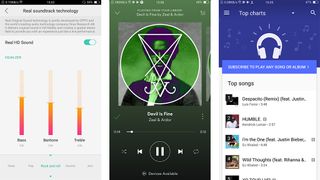Why you can trust TechRadar
Camera
- 16MP front and back cameras for all occasions
- Beautify 4.0 makes a welcome return
Rather impressively, the Oppo R9s Plus, just like the Oppo R9s before it, has 16MP rear and front-facing cameras. The primary camera features a customised 1/2.8 inch Sony-developed IMX398 sensor with an extra-wide F1.7 aperture for improved low-light photography, created for the R9s and R9s Plus.
In our experience, it performed almost exactly like the R9s, in that it took great photos during daylight hours.

In low light situations, shots of perfectly still objects worked quite well, accurately capturing images with very little noise present. Introduce movement however, and these shots end up blurry.

Video capture works well, though again like the R9s, it shoots best at 1080p or below. 4K capture at 30fps is available, our test footage at this resolution was quite choppy, particularly any kind of movement.
Still, the Oppo R9s Plus' primary sensor is wonderful for day-to-day photography. This is thanks to the camera’s dual PDAF (phase detection autofocus) technology, which allows the phone to snap into focus fairly quickly, so you don't have to worry about missing the moment.

Flip the phone over, and you have a 16MP camera that provides a great selfie experience. Its 1/3-inch sensor sports a f2.0 aperture for surprisingly good low light shots. Oppo's Beautify 4.0 software is back and has some minor tweaks to make you look even more youthful and rosy.
Music
- Software-based equaliser offers some customisation
- Volume needs to be up high to enjoy music and movies
Oppo’s built-in equaliser offers ten different presets, with room for a custom setting. There are three sliders to change bass, baritone and treble, and they’re fine if you’re not too fussy. With the ‘Real HD Sound’ turned on, tracks played through Google Music came through with a touch more clarity, and with enough fiddling it could bring a bit more life to Spotify.
Get used to whacking the volume to about 75%, even in quiet areas, to really hear what the R9s Plus can do. At times it can be surprising, though we’re not sure we’d really back the manufacturer’s claims that its system makes music sound just like a live venue. Thankfully, there are no tacky reverb or echo effects.
Music over Bluetooth to a set of Bose QuietComfort 35 headphones played with no stutter or lag, though the volume controls here didn’t correspond to the volume on the R9s Plus. To save our ears, we set the volume on the phone to around 80%, then tweaked the volume on the QC35 set as we needed it.

Paul Taylor is chair of the Royal Academy of Engineering’s Enterprise Hub SME Leaders Steering Group and and Cybersecurity Partner at KPMG.

